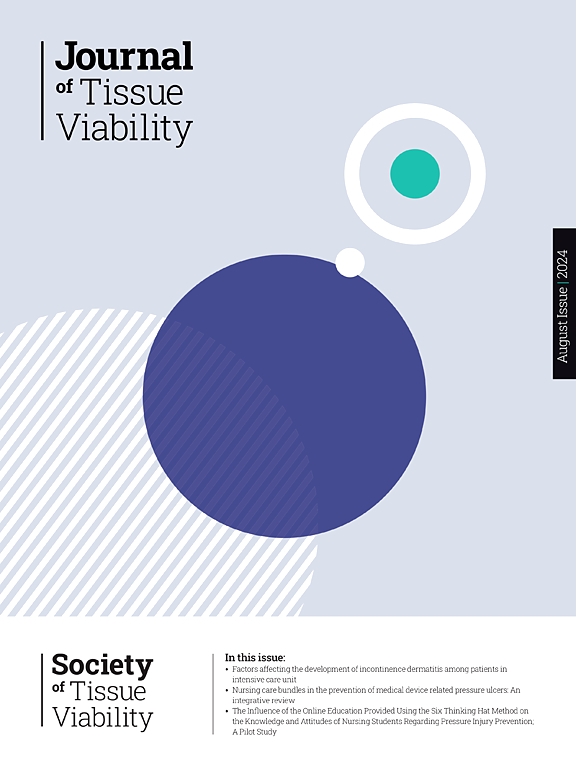Effect of cuff pressure and protective padding material selection on the prevention of skin complications associated with pneumatic tourniquet application in upper extremity surgery: A randomized controlled clinical trial
IF 2.4
3区 医学
Q2 DERMATOLOGY
引用次数: 0
Abstract
Purpose
This study investigated the effect of cuff pressure and the selection of protective padding material (PPM) on the prevention of skin complications associated with pneumatic tourniquet (PT) application in upper extremity surgery.
Methods
This randomized controlled trial was conducted between October 2022 and September 2023 at the Hand Surgery Clinic of Bursa City Hospital. Standard tourniquet pressure (STP) or limb occlusion pressure (LOP) was applied as PT cuff pressure. Cotton pad (CP) or elastic stockinette (ES) was used for PPM under the cuff. Patients were categorized into four groups; (i) STP with a CP; (ii) STP with an ES; (iii) LOP with a CP; and (iv) LOP with an ES. Total of 200 patients were included in the study, with 50 patients in each group. Skin complications were evaluated postoperatively at 0, 30, and 180 min.
Results
Four different skin complications were observed: redness, tourniquet scar, petechiae, and bullae. Redness was higher at 0 min in the group with STP using a CP and at 30 min in the group with LOP using an ES. Tourniquet scar was less in the LOP using an ES at 0 and 30 min. Petechiae was more in the STP group with the CP than in the LOP group at 180 min. Bullae were more in the group with STP using a CP at 0, 30, and 180 min.
Conclusion
LOP for the purposes of cuff pressure and the use of an ES as a PPM are recommended to reduce skin complications associated with PT application.
The CTRN
2022–12/5(ClinicalTrials.gov).
一项随机对照临床试验:袖带压力和保护性填充物选择对预防上肢手术中气动止血带应用相关皮肤并发症的影响
目的探讨臂套压力和保护垫材料(PPM)的选择对预防上肢手术中使用气动止血带(PT)相关皮肤并发症的影响。方法本随机对照试验于2022年10月至2023年9月在布尔萨市医院手外科诊所进行。PT袖带压力采用标准止血带压力(STP)或肢体闭塞压力(LOP)。棉垫(CP)或弹性短袜(ES)用于袖带下的PPM。患者分为四组;(i)具有CP的STP;(ii)具有ES的STP;(iii)具有CP的LOP;(iv)带有ES的LOP。本研究共纳入200例患者,每组50例。结果观察到4种不同的皮肤并发症:红肿、止血带疤痕、瘀点、大疱。STP组在0分钟使用CP, LOP组在30分钟使用ES,红度更高。在0和30分钟时,使用ES的LOP组止血带疤痕较少。在180分钟时,使用CP的STP组比使用LOP组有更多的瘀点。在使用CP的STP组中,在0、30和180分钟时,使用CP的STP组中有更多的大疱。结论建议使用LOP用于袖带压力和使用ES作为PPM以减少与PT应用相关的皮肤并发症。CTRN2022-12/5 (ClinicalTrials.gov)。
本文章由计算机程序翻译,如有差异,请以英文原文为准。
求助全文
约1分钟内获得全文
求助全文
来源期刊

Journal of tissue viability
DERMATOLOGY-NURSING
CiteScore
3.80
自引率
16.00%
发文量
110
审稿时长
>12 weeks
期刊介绍:
The Journal of Tissue Viability is the official publication of the Tissue Viability Society and is a quarterly journal concerned with all aspects of the occurrence and treatment of wounds, ulcers and pressure sores including patient care, pain, nutrition, wound healing, research, prevention, mobility, social problems and management.
The Journal particularly encourages papers covering skin and skin wounds but will consider articles that discuss injury in any tissue. Articles that stress the multi-professional nature of tissue viability are especially welcome. We seek to encourage new authors as well as well-established contributors to the field - one aim of the journal is to enable all participants in tissue viability to share information with colleagues.
 求助内容:
求助内容: 应助结果提醒方式:
应助结果提醒方式:


